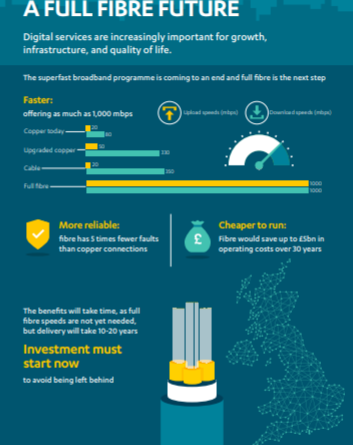What would a National Broadband Plan look like?
The UK telecoms industry is awaiting Government’s Future Telecoms Infrastructure Review which we expect to see over the next few weeks. Whilst it is still unclear what the precise measures will contain the recently published National Needs Assessment from the National Infrastructure Commission offer a few clues.
Their headline recommendation was to call for a National Broadband Plan. So what might such a plan look like and what would it mean for Government policy in telecoms?
Targets
The NIC called for nationwide full fibre broadband by 2033. This helpfully aligns with what the Chancellor, Philip Hammond, called for in a recent speech, although he had also indicated that he wished for the UK to have hit around 15 million premises by 2025.
It goes without saying that these targets are extremely stretching and equate to around 2 million premises connected each year. This will not be easy but it’s welcome that Government is now setting out a path to deliver on these targets – particularly as we have been without meaningful connectivity targets for 6 months, having largely delivered on superfast targets.
Alignment
There are key areas of alignment worth keeping an eye on. Firstly, there may be greater recognition for wireless infrastructure as we move to a 5G world and start to see Government address mobile with the same urgency and recognition in legislation and policy initiatives as it does fibre. This might not result in immediate change but would be an important step nonetheless.
The second is on current Government initiatives. The targets for full fibre have occurred following the introduction of several Government interventions. Some of these align quite well with the full fibre push – as the name suggests, the Local Full Fibre Networks programme is one. Others, some of which are central Government’s responsibility and some are from the devolved bodies seem to be out of joint.
The NIC interestingly included a line on Government intervention, saying that it should “focus initially on the areas least likely to receive full fibre broadband commercially, and which are also most likely to experience unreliable broadband through long distances of copper cables”. This appears to advocate an ‘outside-in’ approach and appears to contravene the approach outlined under the Universal Service Obligation which is aimed at 10Mbit/s services. How these changes could be delivered is hard to say but expect this issue to continue to be raised if it isn’t addressed in some form.
Maximising Private Sector Investment
It’s unlikely that the economics, in terms of positive business case, for full fibre will differ from superfast/NGA networks. In fact there’s the potential for it to be worse as rival companies invest in digging trenches to lay fibre to the same premise. Again the NIC offers a potential solution; let competition flourish in areas where private investment is viable, deploy an ‘outside in’ approach with Government subsidy and meet in the middle. What this middle ground will constitute is harder to make-out but the report does make reference to a ‘targeted solution’. Certainly this area has the potential for Government to deploy an innovative solution which maximises private sector investment, potentially in return for either regulatory or tax holidays.
Barrier Busting
A central theme of Government’s work has rightly focused on removing regulatory, planning, procedural and pretty much anything that detracts from a positive investment environment. Expect to see more detail and action in the FTIR particularly around access to public buildings and trying to drive greater take-up of standardised wayleave agreements.
Whilst these might be the headlines there’ll also be interest in Ofcom’s role, most notably on 5G coverage obligations but also in helping incentivising more fibre deployment, whether the potential impact of Brexit is incorporated, and the role of technologies outside of 5G and full fibre – from satellite to low power wide area networks.






